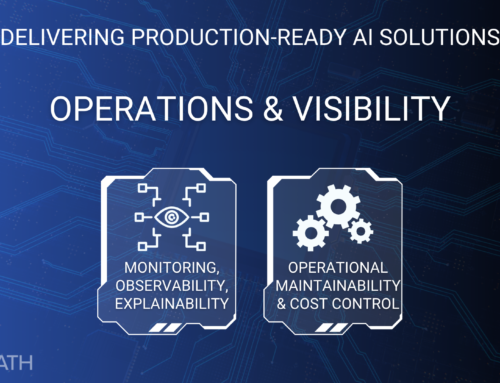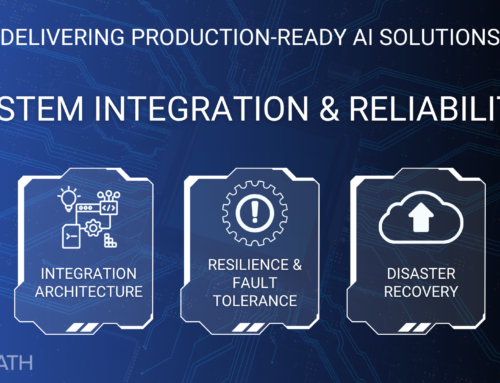Your AI system works flawlessly. The technology is sophisticated, the results are accurate, and the demonstrations are impressive. The deployment goes smoothly. Everything is technically successful.
Six months later, nobody uses it.
This scenario represents one of the most expensive problems in AI implementation: technically successful systems that fail to deliver business value because people either can't or won't use them effectively. The AI performs exactly as designed, but business outcomes remain unchanged because organizational adoption never materializes.
The user adoption paradox reveals a fundamental disconnect in how organizations approach AI deployment. Most efforts focus heavily on making AI technology work while giving minimal attention to making it work for people. This approach consistently produces AI capabilities that exist in technical environments but never integrate into actual business operations.
The Adoption Gap That Kills Business Value
Technical success doesn't guarantee business success. AI systems can demonstrate excellent performance in controlled conditions while failing completely to improve how people actually work.
Interface complexity that intimidates users creates barriers to adoption regardless of underlying AI sophistication. Your document analysis AI might extract insights with remarkable accuracy, but if accessing those insights requires navigating complex screens and interpreting technical outputs, most users will continue working the old way.
Workflow disruption that forces inefficient workarounds prevents adoption when AI systems require people to change established work patterns without providing clear benefits. If your new AI-powered customer service tool requires agents to switch between multiple applications and enter information in unfamiliar formats, they'll avoid using it whenever possible.
Trust gaps that undermine confidence emerge when people can't understand why AI systems make specific recommendations or when early mistakes create lasting skepticism. An AI that occasionally produces obviously wrong results will struggle to gain user acceptance even when it's right most of the time.
Training inadequacy that leaves people unprepared creates adoption barriers when users don't understand how to leverage AI capabilities effectively. People may technically know how to operate AI interfaces but lack the deeper understanding needed to integrate AI into their decision-making processes confidently.
Change resistance that protects established approaches surfaces when organizations introduce AI without adequately addressing the human factors that influence technology adoption. Even beneficial changes can face resistance when people feel imposed upon rather than empowered.
These adoption challenges aren't technical problems that can be solved through better AI models or more sophisticated interfaces. They require systematic attention to human factors, organizational change, and user experience design that many AI projects treat as secondary concerns.
For this reason, CtiPath developed the Production-Ready AI Solutions Framework. The fifth part of that framework is User Adoption & Success.
The Three Elements That Transform AI Capabilities into Business Results
Successfully driving AI adoption requires treating user experience and organizational change as core requirements rather than implementation afterthoughts.
Element 13: User Experience Design – Making AI Feel Natural
User experience design creates interfaces and interactions that encourage adoption by making AI capabilities feel intuitive, trustworthy, and valuable within existing work patterns.
Interface design that matches mental models creates AI interactions that align with how people naturally think about their work rather than requiring them to adapt to AI system logic. Your financial analysis AI should present insights in formats that analysts already understand and trust, not force them to interpret technical model outputs.
Workflow integration that enhances rather than disrupts enables people to access AI capabilities through existing business processes rather than learning entirely new procedures. Sales representatives shouldn't need to export customer data, upload it to an AI system, and import results back into their CRM. The AI should work within their established tools and workflows.
Trust-building through appropriate transparency provides the right level of explanation for different users and decisions. Frontline workers might need simple confidence indicators, while managers require more detailed reasoning, and executives want strategic insights rather than technical details.
Progressive disclosure that manages complexity presents AI capabilities at appropriate levels of sophistication for different users and contexts. New users can access basic functionality immediately while experienced users can leverage advanced features as their comfort and expertise develop.
Error handling that builds rather than undermines confidence acknowledges AI limitations gracefully while helping users understand when and how to rely on AI recommendations. Good UX design treats occasional AI mistakes as learning opportunities rather than trust-breaking failures.
User experience design transforms AI from intimidating technology into helpful business tools that people actually want to use regularly.
Element 14: Training – Building AI Literacy and Confidence
Comprehensive training develops user capabilities that enable effective AI utilization while building organizational confidence in new technologies.
AI literacy that enables informed decision-making teaches users fundamental concepts about how AI works, why it makes mistakes, and how to evaluate AI recommendations appropriately. This education helps people develop good judgment about when to trust, question, or override AI suggestions.
Role-specific training that addresses actual use cases provides targeted education for different user types and responsibilities. Executive training focuses on strategic implications and business value, while operational training emphasizes daily workflow integration and practical application.
Hands-on practice with realistic scenarios enables users to develop confidence through experience with actual business situations rather than abstract training examples. People learn best when they can practice AI utilization in contexts that mirror their real work environment and challenges.
Ongoing support that adapts to growing expertise provides continued learning opportunities as users become more sophisticated and as AI capabilities evolve. Initial training gets people started, but sustained value requires ongoing skill development and adaptation to new features or applications.
Peer learning networks that share best practices enable users to learn from each other's experiences and develop organizational knowledge about effective AI utilization. These networks often become more valuable than formal training as people discover practical applications and workarounds.
Change management that addresses resistance systematically acknowledges that AI adoption often requires people to work differently and provides appropriate support for that transition. Effective change management treats resistance as a normal response that requires understanding and support rather than a problem to overcome.
Training transforms AI from foreign technology into familiar business capability that people can leverage confidently for improved outcomes.
Element 15: Change Management and Version Control – Managing Evolution
Change management coordinates organizational adaptation to AI capabilities while providing deployment governance that enables safe system evolution without disrupting business operations.
Stakeholder engagement that builds support involves affected users, managers, and customers in AI implementation planning to ensure that deployments address real needs and concerns rather than imposing technological solutions that don't match business requirements.
Communication strategies that maintain confidence keep stakeholders informed about AI implementation progress, benefits realization, and issue resolution while setting appropriate expectations about capabilities and limitations.
Feedback mechanisms that drive improvement capture user experiences and suggestions to guide AI system optimization and organizational adaptation. These mechanisms help identify adoption barriers and optimization opportunities that might not be obvious from technical monitoring alone.
Version control that enables safe evolution provides systematic approaches to AI system updates that minimize business disruption while enabling continuous improvement. Users need confidence that AI systems will continue working reliably as new features are added and performance improvements are deployed.
Rollback capabilities that protect against regression ensure that AI system updates that don't work as expected can be reversed quickly without significant business impact. This safety net encourages experimentation and improvement while protecting against deployment mistakes.
Organizational learning that captures knowledge documents successful adoption patterns, lessons learned, and best practices that can guide future AI initiatives and help other parts of the organization benefit from early adopters' experiences.
Change management transforms AI deployment from disruptive technology implementation into systematic organizational capability development that builds on success and minimizes risks.
How User Adoption Elements Create Sustainable AI Success
Organizations that invest properly in user experience, training, and change management experience fundamentally different AI outcomes than those that focus purely on technical deployment.
High adoption rates that maximize AI investment value because people actively use AI capabilities rather than working around them or ignoring them entirely. Technical capabilities translate directly into business value through widespread, effective utilization.
Positive user experiences that drive expansion create organizational momentum for additional AI applications because early adopters become advocates who help drive broader acceptance and support for AI initiatives.
Organizational confidence that enables ambitious applications develops when people see evidence that AI implementations deliver promised benefits while maintaining quality and reliability standards. This confidence supports deployment in more critical processes and larger strategic investments.
Continuous improvement through user feedback enables AI systems to evolve based on actual usage patterns and business needs rather than theoretical requirements or vendor roadmaps.
Knowledge retention that protects AI investments ensures that organizational learning about effective AI utilization doesn't disappear when key people change roles or leave the organization.
Competitive advantage through effective AI utilization emerges when organizations become genuinely good at leveraging AI capabilities rather than just deploying AI technology. The competitive advantage comes from organizational capability, not just technical sophistication.
Questions That Reveal Adoption Readiness
When evaluating AI initiatives, these questions reveal whether user adoption concerns are properly addressed:
User Experience Design: How do users access AI capabilities within their existing workflows? What happens when AI systems make mistakes or provide unclear recommendations? How does the interface adapt to different user expertise levels and business contexts?
Training and Support: What preparation do users receive for working effectively with AI systems? How do you address different learning needs across user populations? What ongoing support helps users develop more sophisticated AI utilization skills over time?
Change Management: How do you handle resistance and adoption challenges? What feedback mechanisms capture user experiences and guide system improvements? How do you manage AI system updates without disrupting business operations?
Business Impact: How do you measure whether people are actually using AI capabilities effectively? What evidence shows that AI adoption is improving business outcomes? How do you optimize for user value rather than just technical performance?
Detailed answers that address human factors and organizational dynamics suggest mature approaches to AI adoption. Technical responses that focus on AI capabilities without considering user needs indicate gaps that will limit business value regardless of technical sophistication.
The Investment That Turns Technology into Business Value
Building comprehensive user adoption capabilities requires more attention to human factors than many AI projects allocate. But this investment creates sustainable competitive advantages:
Widespread utilization that maximizes return on AI investment because people actively use AI capabilities rather than working around technological barriers or adoption challenges.
Rapid value realization because effective user adoption accelerates the timeline from AI deployment to measurable business impact.
Organizational learning that enables increasingly sophisticated AI utilization over time as people develop expertise and confidence in working with AI capabilities.
Strategic competitive advantage through organizational capability to leverage AI effectively rather than just deploy AI technology. Competitors can copy technology, but organizational expertise is much harder to replicate.
Sustainable growth in AI utilization because positive user experiences create momentum for additional AI applications and more ambitious use cases.
Risk mitigation through user adoption approaches that build confidence and trust rather than creating organizational resistance that can undermine AI initiatives.
Beyond Technical Success: Building AI That Changes How Work Gets Done
The AI transformation is real, but capturing its benefits requires treating user adoption as a core requirement rather than an implementation afterthought.
Organizations that invest comprehensively in user experience design, training programs, and change management position themselves to capture AI's competitive advantages through effective organizational utilization. Those that assume technical AI deployment will automatically improve business outcomes often discover that impressive technology capabilities remain unused because nobody addressed the human factors that determine adoption success.
AI technology works, but business value emerges only when people can and will use that technology effectively within their actual work environment. The gap between technical capability and business impact gets bridged through systematic attention to user needs, organizational change, and the human factors that determine whether AI enhances or complicates how work gets done.
The question isn't whether AI can improve your business operations. It's whether people will actually use AI capabilities in ways that deliver that improvement consistently over time.





